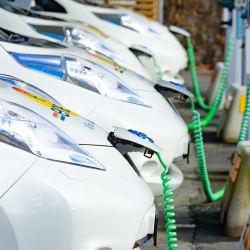
A new economic claim from the American Lung Association of California regarding Zero Emission Vehicles and their potential health benefits has us all living in an episode of The Oprah Winfrey Show.
But, their statement goes way beyond,"You get a car, you get a car, you get a car!"
Their analysis postulates that a big push in the usage of Zero Emission Vehicles (ZEVs) will allow Americans to save billions of dollars in health costs each year, along with thousands of lives. Unfortunately, that's a promise not even Oprah could make happen.
A Zero Emission Vehicle is a vehicle that directly produces no harmful emissions - some don't even have a tailpipe. There are currently two categories of zero emission vehicles: 1) battery powered electric cars that recharge when plugged in and 2) hydrogen fuel cell models that are powered by a chemical reaction. This latter category is not only very rare, but, it is hotly contested whether these ZEVs are better for the environment than the cars that we drive now. They have to convert a hydrocarbon fuel (natural gas or gasoline) into hydrogen - which uses substantial energy and emits greenhouse gases.
There are roughly 230,000 zero-emission cars currently on the road in California and another 270,000 throughout the rest of the US. Those electrics cars are overwhelmingly powered by coal and natural gas and each electric charger is equivalent to an entire home in load on the electric grid. Sixty seven percent of electricity that goes on the grid is from fossil fuels.That's hardly zero emissions.
Yet the analysis indicates that a widespread shift to zero-emission vehicles (ZEVs) in ten states would "clean the air and curb dangerous health and climate impacts, resulting in cost savings of tens of billions of dollars a year to society." We at the Council are not here to talk about the impact on the climate, that is another column for another organization, but this claim that electric vehicles will save lives is our area of expertise.
Because of similar hyperbolic claims, we have been talking about pollution and health for years, and so I am happy to weigh in regarding this claim. It simply does not add up.
The report estimates that, in the ten states where they want to implement the change to ZEV, the positive financial impact will be due to a decrease on the number of asthma attacks, days of work lost to respiratory illness, premature deaths, heart attacks and ER visits/hospitalizations. It is always suspicious when groups invoke "pretend money" and claim that they will save it. Obviously, people do require medical services for these ailments, but it is far-fetched to suggest that they are all caused by pollution, especially when there is so little of it in the United States.
Even worse, Normal Edelman, a doctor and senior scientific adviser to the American Lung Association, was quoted as saying, “Air pollution makes people sick and it can even kill. Emissions from the tailpipes of cars includes pollutants that trigger asthma attacks, cause lung cancer, and shorten life.’’
Dr. Stan Young here at the Council analyzed over two million California deaths from 2000-2012 and his 37,000 days of data has to be one of the largest air quality/acute mortality data sets ever analyzed. He found that air quality, ozone and small particulate matter in air pollution weren't causal in those deaths.
If the goal is to inform public health discussions, why wouldn't the American Lung Association of California use that information?
Outdoor air pollution is certainly not a major (is hardly even a minor) cause of lung cancer, a fact that ACSH has long been trying to educate the public about. Outdoor air pollution is estimated to account for one to two percent of lung cancer cases. Instead, smoking is responsible for upwards of 90 percent of lung cancer cases and that is why we have been so vocal about smoking for 38 years. Pollution can certainly exacerbate asthma and people living with chronic obstructive pulmonary disease (COPD,) but, will replacing your car with a ZEV in 10 states really even make a difference? If they were really interested in lowering pollution, they should target the emissions released from power plants, manufacturing facilities (factories), waste incinerators, furnaces, air conditioning and anything else that requires energy as they account for the major sources (over half) of emissions in the US. Here are their estimates of cost savings by 2050:
- California $13.5 billion
- Connecticut $1.3 billion
- Maine $0.5 billion
- Maryland $2.4 billion
- Massachusetts $2.7 billion
- New Jersey $4.1 billion
- New York $7.1 billion
- Oregon $1.1 billion
- Rhode Island $0.4 billion
- Vermont $0.3 billion
Vermont? $313 million? There are only 626,000 people in Vermont - 80% of them are over 18. Let's say that each and every one of them gets a ZEV - that means 500,800 ZEV cars are on the road - and that each one saves their owner $626 in health care costs. From scant air pollution. It doesn't add up, especially in a state like Vermont where energy costs are at an all time high.
Working towards a cleaner environment is a great goal and, we can certainly get behind realistic efforts to improve health. But, linking pollution to certain health threats such as lung cancer is simply not accurate. The makers of ZEVs can make a lot of promises, but, if the sales pitches stray away from the comfy seats or the surround sound, to how the car will save you money on your health costs - well, then you should take a bottle of the free snake oil that comes with the car.
